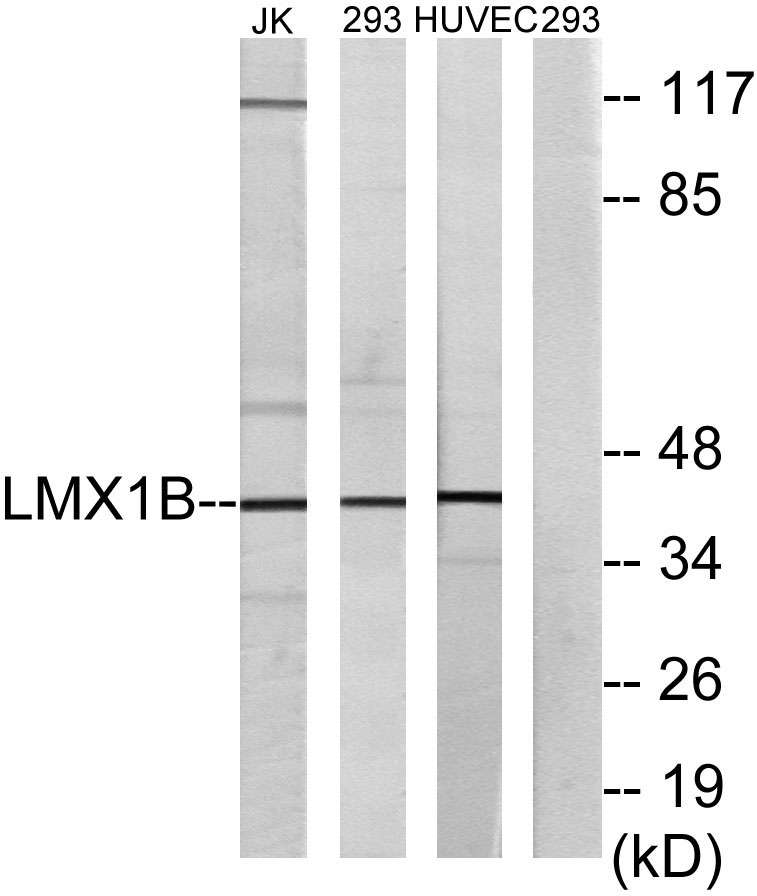LMX1B Polyclonal Antibody
- Catalog No.:YT2577
- Applications:WB;IHC;IF;ELISA
- Reactivity:Human;Mouse
- Target:
- LMX1B
- Gene Name:
- LMX1B
- Protein Name:
- LIM homeobox transcription factor 1-beta
- Human Gene Id:
- 4010
- Human Swiss Prot No:
- O60663
- Mouse Gene Id:
- 16917
- Mouse Swiss Prot No:
- O88609
- Immunogen:
- The antiserum was produced against synthesized peptide derived from human LMX1B. AA range:126-175
- Specificity:
- LMX1B Polyclonal Antibody detects endogenous levels of LMX1B protein.
- Formulation:
- Liquid in PBS containing 50% glycerol, 0.5% BSA and 0.02% sodium azide.
- Source:
- Polyclonal, Rabbit,IgG
- Dilution:
- WB 1:500 - 1:2000. IHC 1:100 - 1:300. ELISA: 1:40000.. IF 1:50-200
- Purification:
- The antibody was affinity-purified from rabbit antiserum by affinity-chromatography using epitope-specific immunogen.
- Concentration:
- 1 mg/ml
- Storage Stability:
- -15°C to -25°C/1 year(Do not lower than -25°C)
- Other Name:
- LMX1B;LIM homeobox transcription factor 1-beta;LIM/homeobox protein 1.2;LMX-1.2;LIM/homeobox protein LMX1B
- Observed Band(KD):
- 40kD
- Background:
- LIM homeobox transcription factor 1 beta(LMX1B) Homo sapiens This gene encodes a member of LIM-homeodomain family of proteins containing two N-terminal zinc-binding LIM domains, 1 homeodomain, and a C-terminal glutamine-rich domain. It functions as a transcription factor, and is essential for the normal development of dorsal limb structures, the glomerular basement membrane, the anterior segment of the eye, and dopaminergic and serotonergic neurons. Mutations in this gene are associated with nail-patella syndrome. Alternatively spliced transcript variants encoding different isoforms have been found for this gene. [provided by RefSeq, Mar 2010],
- Function:
- disease:Defects in LMX1B are the cause of nail-patella syndrome (NPS) [MIM:161200]; also knowan as Onychoosteodysplasia. NPS is a disease that cause abnormal skeletal patterning and renal dysplasia.,function:Essential for the specification of dorsal limb fate at both the zeugopodal and autopodal levels.,similarity:Contains 1 homeobox DNA-binding domain.,similarity:Contains 1 LIM zinc-binding domain.,similarity:Contains 2 LIM zinc-binding domains.,tissue specificity:Expressed in most tissues. Highest levels in testis, thyroid, duodenum, skeletal muscle, and pancreatic islets.,
- Subcellular Location:
- Nucleus .
- Expression:
- Expressed in most tissues. Highest levels in testis, thyroid, duodenum, skeletal muscle, and pancreatic islets.
- June 19-2018
- WESTERN IMMUNOBLOTTING PROTOCOL
- June 19-2018
- IMMUNOHISTOCHEMISTRY-PARAFFIN PROTOCOL
- June 19-2018
- IMMUNOFLUORESCENCE PROTOCOL
- September 08-2020
- FLOW-CYTOMEYRT-PROTOCOL
- May 20-2022
- Cell-Based ELISA│解您多样本WB检测之困扰
- July 13-2018
- CELL-BASED-ELISA-PROTOCOL-FOR-ACETYL-PROTEIN
- July 13-2018
- CELL-BASED-ELISA-PROTOCOL-FOR-PHOSPHO-PROTEIN
- July 13-2018
- Antibody-FAQs
- Products Images

- Western blot analysis of lysates from Jurkat, 293, and HUVEC cells, using LMX1B Antibody. The lane on the right is blocked with the synthesized peptide.

- Immunohistochemical analysis of paraffin-embedded human tonsil. 1, Antibody was diluted at 1:200(4° overnight). 2, Tris-EDTA,pH9.0 was used for antigen retrieval. 3,Secondary antibody was diluted at 1:200(room temperature, 45min).



